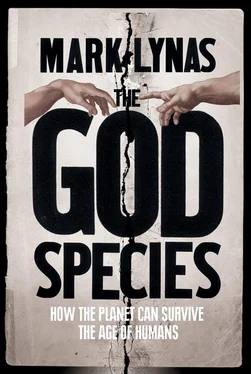This kind of talk makes many environmentalists queasy. Greens generally view biodiversity conservation as a moral cause, and any discussion of financial mechanisms and marketing schemes arouses strong and principled opposition. Why should any other species, each with just as much right to occupy this living Earth as us, be forced to ‘pay its way’? This objection is understandable but wrong-headed: what I am proposing is not a liquidation of nature to make money, but using money simply as a convenient means to safeguard its protection. Money is a measure of value: put a price on wild animals and plants and we will put a value on them too. This is a pragmatic strategy, only to be used in desperation because the others have failed.
But how can the value of natural systems be quantified, let alone brought into the market? A possible approach is to try to assign an imputed shadow price to the ecosystem services – fresh water, clean air, recreational benefits and so on – that different habitats deliver. One study suggests a value of $200,700 per square kilometre for ‘high-biodiversity wilderness areas’, whilst another finds that ‘endemic bird areas’ might be worth $88,710 per square kilometre. 46 Конец ознакомительного фрагмента. Текст предоставлен ООО «ЛитРес». Прочитайте эту книгу целиком, купив полную легальную версию на ЛитРес. Безопасно оплатить книгу можно банковской картой Visa, MasterCard, Maestro, со счета мобильного телефона, с платежного терминала, в салоне МТС или Связной, через PayPal, WebMoney, Яндекс.Деньги, QIWI Кошелек, бонусными картами или другим удобным Вам способом.
The imputed value of coral reefs – as destinations for tourism, nurseries for commercially valuable fish and shoreline protectors against storms, for example – has ranged from $100,000 to $600,000 per square kilometre. 47 Конец ознакомительного фрагмента. Текст предоставлен ООО «ЛитРес». Прочитайте эту книгу целиком, купив полную легальную версию на ЛитРес. Безопасно оплатить книгу можно банковской картой Visa, MasterCard, Maestro, со счета мобильного телефона, с платежного терминала, в салоне МТС или Связной, через PayPal, WebMoney, Яндекс.Деньги, QIWI Кошелек, бонусными картами или другим удобным Вам способом.
The values of individual species have also been quantified, based on estimates from public surveys of ‘willingness to pay’ to prevent their elimination. Using this methodology (and in 2005 US dollars) the Eurasian red squirrel is worth $2.87; the California sea otter $36.76; the giant panda $13.81; the Mediterranean monk seal (almost extinct): $17.54; the blue whale: $44.57; the brown hare: $0.00; the Asian elephant: $1.94; the Northern spotted owl: $59.43; and the loggerhead sea turtle: $16.98. 48 Конец ознакомительного фрагмента. Текст предоставлен ООО «ЛитРес». Прочитайте эту книгу целиком, купив полную легальную версию на ЛитРес. Безопасно оплатить книгу можно банковской картой Visa, MasterCard, Maestro, со счета мобильного телефона, с платежного терминала, в салоне МТС или Связной, через PayPal, WebMoney, Яндекс.Деньги, QIWI Кошелек, бонусными картами или другим удобным Вам способом.
One team of scientists, led by Robert Costanza – a member of the planetary boundaries expert group – even went so far as to publish an aggregate monetary value of the whole biosphere. There is a conceptual flaw in this, as many have pointed out, because the human economy is a subset of the natural biosphere and could not in any conceivable way replace it. As one environmental scientist sniffed: when it comes to pricing the biosphere as a whole, ‘there is little that can usefully be done with a serious underestimate of infinity.’ 49 Конец ознакомительного фрагмента. Текст предоставлен ООО «ЛитРес». Прочитайте эту книгу целиком, купив полную легальную версию на ЛитРес. Безопасно оплатить книгу можно банковской картой Visa, MasterCard, Maestro, со счета мобильного телефона, с платежного терминала, в салоне МТС или Связной, через PayPal, WebMoney, Яндекс.Деньги, QIWI Кошелек, бонусными картами или другим удобным Вам способом.
Even so, Costanza and colleagues came up with a precise figure for ‘the total economic value of the planet’ of $33 trillion per year (as compared with a total global GNP of, when the paper was written in 1997, $18 trillion). 50 Конец ознакомительного фрагмента. Текст предоставлен ООО «ЛитРес». Прочитайте эту книгу целиком, купив полную легальную версию на ЛитРес. Безопасно оплатить книгу можно банковской картой Visa, MasterCard, Maestro, со счета мобильного телефона, с платежного терминала, в салоне МТС или Связной, через PayPal, WebMoney, Яндекс.Деньги, QIWI Кошелек, бонусными картами или другим удобным Вам способом.
The problem with these figures however is not that they are too precise but that they are not real. No one pays anyone else $33 trillion a year to protect the planet from destruction, nor are any of us actually forking out $17.54 to keep Mediterranean monk seals from going extinct. Yet in a globalised capitalist economy actual, real-world revenue flows are essential if they are to compete with the commercial drive that is destroying and displacing the remaining bits of natural ecosystem worldwide. Mangroves may be valuable as protection against storms and shelter for fish, but someone needs to be paid to look after them if they are not to be chopped down to make way for lucrative shrimp farms. In other words, a financial constituency needs to be created that has a vested interest in protecting its assets – assets that are, in this case, natural rather than commercial capital.
The starting point for this process has to be valuing natural capital. As Pavan Sukhdev, lead author of the 2010 The Economics of Ecosystems & Biodiversity ( TEEB ) report, is fond of saying: ‘You cannot manage what you do not measure.’ One of the report’s key recommendations is that the present system of national accounts should be ‘rapidly upgraded to include the value of changes in natural capital stocks and ecosystem service flows’. The TEEB report consciously encourages the use of banking and accounting terminology with regard to biodiversity: its authors have launched a ‘Bank of Natural Capital’ website to encourage wider awareness of the ideas it raises. This even extends to proposing an ‘internal rate of return’ for ecosystems, which varies from 40 per cent for woodlands to 50 per cent for tropical forests to 79 per cent for better-managed grasslands. 51 Конец ознакомительного фрагмента. Текст предоставлен ООО «ЛитРес». Прочитайте эту книгу целиком, купив полную легальную версию на ЛитРес. Безопасно оплатить книгу можно банковской картой Visa, MasterCard, Maestro, со счета мобильного телефона, с платежного терминала, в салоне МТС или Связной, через PayPal, WebMoney, Яндекс.Деньги, QIWI Кошелек, бонусными картами или другим удобным Вам способом.
‘The flows of ecosystem services can be seen as the “dividend” that society receives from natural capital,’ the TEEB Synthesis Report suggests. 52 Конец ознакомительного фрагмента. Текст предоставлен ООО «ЛитРес». Прочитайте эту книгу целиком, купив полную легальную версию на ЛитРес. Безопасно оплатить книгу можно банковской картой Visa, MasterCard, Maestro, со счета мобильного телефона, с платежного терминала, в салоне МТС или Связной, через PayPal, WebMoney, Яндекс.Деньги, QIWI Кошелек, бонусными картами или другим удобным Вам способом.
Читать дальше











